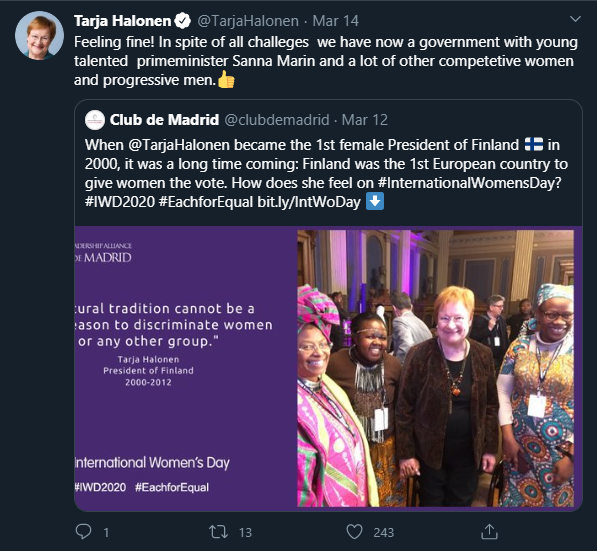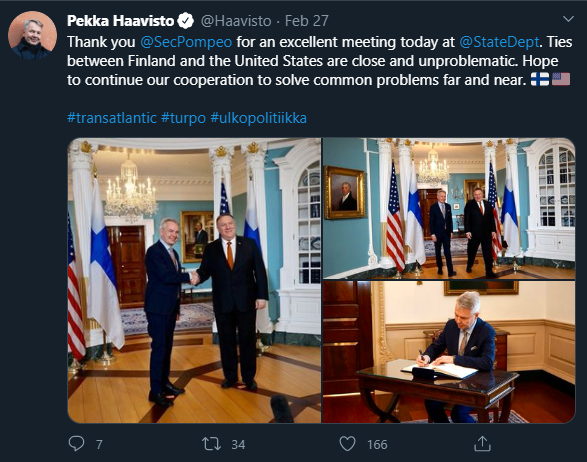Veera, Jenna and Karoliina
Introduction
According to Andrea Ceron (2017), a politician having an account on Twitter or a Facebook page has become extremely common: as many as two-thirds of the world’s politicians are reported to be active on social media today. Politicians become more active during an electoral campaign in order to strategically promote both themselves and their respective political parties, but there is a considerable number of people in politics who use social media in a multitude of ways, even outside campaigning periods. They use it to deliver public comments on recent events and their personal views and opinions on various topics, including ones unrelated to politics. Their public image is carefully maintained, however, as the public nature of social media holds them accountable by comparing their actual and declared behavior. Their interactions are constantly observed and evaluated on whether they are a normal everyday practice or simply a tactical tool to use to their advantage in order to advance their political careers, without any actual intentions on following through with what they have promised to deliver. (Ceron, 2017.)
The transcultural nature of social media transcends country borders, which allows politicians to be internationally connected to all the corners of the world. Therefore, even politicians from countries where English is not a native language still use it in their public messaging. There is plenty of variation in its usage, however, as different contexts and the politician’s status and image affect their ways of communication as a whole, including also their language choices and semiotic and linguistic repertoires. Our focus in this study is to examine how Finnish politicians use English in their interactions on social media, as well as how their discourse is affected by the digital settings and associated elements.
Process
For this study we wanted to take a closer look at English in Finnish social media, so we discussed various platforms and people who we would like to inspect. Finally, we chose Finnish politicians as our research subject, to inspect whether some of the most well-known Finnish politicians use English in their social media, how they use it and for what purposes. In order to study this, we observed the Twitter accounts of multiple politicians and searched for occasions where they have interacted in English. What we found was that most Finnish politicians tweet mostly or exclusively in Finnish. Some use English on occasion, however, so we took screenshots of these posts and accounts, picked the ones we wanted to use in this study and analyzed them.

Figure 1

Figure 2
In Figures 1 and 2 we see the public Twitter profiles of President Sauli Niinistö and former Prime Minister Alexander Stubb. Both are and have been prominent figures in Finnish politics, but their different social standings are reflected in their profiles in a number of ways. In Niinistö’s biography there is code-switching, as it states his status as the president of Finland in three languages: Finnish, Swedish and English. Thus, English is acknowledged as an equally important language alongside the official languages of Finland. In comparison, Stubb’s profile is written entirely in English, and it uses multiple English abbreviations such as “MEP” (Member of the European Parliament) and “PhD” (Doctor of Philosophy.) After leaving Finnish politics Stubb worked as the Vice-President of the European Investment Bank until January 2020, and will start as the Director and Professor of the School of Transnational Governance in May this year. (Wikipedia, 2020.) Stubb’s more international status shows in his exclusively English profile, as well as the sentence “Europe is about your heart and mind” written in his header picture. The biography as a whole has a more casual tone than Niinistö’s, by using descriptors like “bookworm.” Therefore, we can conclude that the English in Niinistö’s profile has the pragmatic purpose of making the information more available on a social media page that is mostly frequented by Finnish people, including non-Finnish speakers, whereas Stubb’s profile uses English exclusively in order to be understood by his more multilingual and multicultural audience.

Figure 3
The third figure presents a Twitter post from Niinistö. When examining Niinistö’s language use one should take into consideration his work, which is closely related to international relations. As such, it illustrates some of the reasons for choosing a particular language for international purposes (Crystal, 2012). This post mentioned German Federal President, the corona pandemic and international cooperation on medical research. All these features are somehow international and not limited to the Finnish-speaking public only. Niinistö’s use of English in his post also reflects the global status of English and its wide use inside the European Union as well. In fact, European Commission uses only three working languages for internal matters; English, French and German to a lesser extent (Mamadouh, 2002). It seems that Niinistö’s use of English indeed is in accordance with his work, regarding international relations and it would be in line with the language policies inside the EU. Moreover, this platform itself is international and meant to reach lots of people.

Figure 4

Figure 5
In Figures 4 and 5 the former president of Finland Tarja Halonen and Sauli Niinistö wish to direct the attention of their followers to the internationally important causes of women’s and children’s rights and well-being. Halonen reminds her followers that matters regarding the health of women and children still need to be worked on and encourages them to take action, too. She has attached a link to an article on the website of Every Woman Every Child (EWEC), a movement devoted to” address the major health challenges facing women, children and adolescents around the world” (everywomaneverychild.org). Niinistö’s tweet on International Women’s Day emphasises that overall stability, security, and peace must be enhanced to increase equality and that merely focusing on the well-being of women and girls is not enough.
The subjects of these tweets make the choice of English valid and logical: these are issues that touch the lives of millions worldwide and require international efforts to be resolved, and as (former) presidents they have some international prestige, which would be wasted if these tweets had been written in Finnish. In Halonen’s tweet it also makes sense to have her own input in English, as the article she links it to is also in English.

Figure 6
In Figure 6 Halonen retweets and responds to a tweet by Club de Madrid, a non-profit organisation that, according to their Twitter profile, promotes democratic values, good governance, and well-being globally. The theme of this tweet is also the International Women’s Day, even though Club de Madrid’s tweet was published four days after the day. Club de Madrid wants to ask Halonen, Finland’s first woman president, how she feels on the International Women’s Day. She replies by praising the prime minister of Finland, Sanna Marin and other progressive members of the Finnish government.
As this tweet is a direct reply to another tweet, the only choice Halonen had was to write her tweet in English. In this example it is also interesting to note that in a social media setting even someone as influential as a former president can make typos (challeges) and spelling errors (competetive), as these types of posts are rarely reviewed before posting. Had this set of tweets had a more controversial topic or if they had been a part of an argument, she might have been ridiculed for these very human mistakes, but in this jovial exchange it is ignored.

Figure 7

Figure 8
Figures 7&8 present more casual and personal communication. It seems that the slightly different public image and work of Stubb allows more freedom in terms of his language use. However, English is used to reach Stubb’s multilingual and multicultural audience. His use of the interjection “Go figure” indicates a more informal approach which is common for Twitter (Lockyer, 2014: 72). Figure 8, in particular, expresses Stubb’s attitude and reaction to a situation shown in the picture. In addition to the strong interactional element, there is a sense of playfulness and immediacy which are characteristic of Twitter (Lockyer, 2014: 72). The hashtag #Finland seems to have two functions: it serves (1) as a topic marker; and (2) as a lexical item that is part of the main message. One should also point out that the messages are concise, which is due to Twitter’s policy of only allowing 140 characters per tweet.

Figure 9
In Figure 9 Finland’s secretary of state Pekka Haavisto thanks Mike Pompeo, the secretary of State of the USA, for meeting with him. He also shares pictures of the event. He announces that the two countries are in excellent terms with one another and are working together to solve common problems.
As the tweet is a thank you message to an English-speaking person, whose own Twitter account is linked to the tweet, the only rational choice of language is English. A tweet like this may also interest the followers of Pompeo’s Twitter account, as well as the American and international press, and writing it in English makes it accessible to these audiences. Interestingly, though, Haavisto seems to think the main audience for his tweet are Finns: two of the three hashtags used are in Finnish.
Conclusion
Today’s politicians are highly involved in social media communication. Through these platforms they are able to reach their multilingual and multicultural audiences and deliver their comments and personal opinions on various topics.
Even though Finnish politicians mostly interact in Finnish on social media, this small study found that those politicians that do use English, do so in various ways and for different reasons. They use it to introduce themselves to the social media audiences, to recount interactions with politicians from other countries, to bring attention to global phenomena and issues, to directly interact with other social media users and to share little snippets of their private lives. Finnish politicians are also well-versed in the Twitter etiquette, as they fluently use hashtags and tags for other accounts as well as share articles and retweet posts made by other users of the platform. While the discourse of the tweets is mostly quite formal, it is more intimate and jovial than politicians’ interactions via the press or television news broadcasts. For example, the more personal tweets by Stubb are something that would not have been expected from a politician before the emergence of social media but is perfectly acceptable now in a social media setting.
References
Ceron, Andrea. 2017. Social media and political accountability: bridging the gap between citizens and politicians. Cham, Switzerland: Palgrave Macmillan.
Crystal, D. 2012. English as a global language. Canto classics edition. Cambridge: Cambridge University Press.
Every Woman Every Child https://www.everywomaneverychild.org/about/#sect1
Lockyer, D. 2014. The emotive meanings and functions of English ‘diminutive’ interjections in Twitter posts. SKASE Journal of Theoretical Linguistics, 11(2), p. 68.
Mamadouh, V. 2002. Dealing with multilingualism in the European Union: Cultural theory rationalities and language policies. Journal of Comparative Policy Analysis: Research and Practice: Cultural Theory and Its Contribution to Policy Analysis, 4(3), pp. 327-345.
Twitter. Information retrieved on 16.04.2020 from the following web pages:
twitter.com/alexstubb
twitter.com/haavisto
twitter.com/clubdemadrid
twitter.com/niinisto
twitter.com/tarjahalonen
Wikipedia. Alexander Stubb. Information retrieved on 16.04.2020 from the following web page: https://en.wikipedia.org/wiki/Alexander_Stubb
